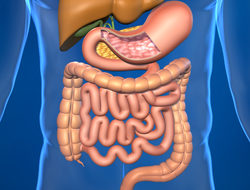Your Small Intestine: An overview
Published: December 03, 2020
The small intestine is part of your gastrointestinal (GI) tract.
This 3 metre long tube is located between your stomach and your large intestine, and is a major site of digestion.
It is within your small intestine that most of the nutrients contained in the foods and beverages you consume are broken down into tiny molecules which can be absorbed into your body.
As with other sections of your GI tract, the walls of your small intestine consist of the characteristic longitudinal and circular smooth muscles.
These muscles sustain peristalsis: the periodic wave-like muscular contractions which move ingested food along your GI tract as part of the digestive process.
The central space of your small intestine, through which your food passes, is called the lumen.
Imagine the tube in the centre of a roll of paper towels, only instead of a smooth interior surface the surface of the wall of your small intestine is folded or pleated.
This arrangement increases the surface area and absorptive capacity of your small intestine which improves the efficacy of your digestive process.
You liver, gall bladder, and pancreas are auxiliary organs and are closely associated with the functioning of your small intestine. These auxiliary organs produce bile and pancreatic juice which facilitate the digestion and absorption processes.
Bile and pancreatic juices are released into the duodenum (a section of your small intestine) through the bile and pancreatic ducts. CCK, a hormone produced and released from intestinal cells, promotes release of bile and pancreatic juice.
Bile consists of bile acids/salts, pigments, cholesterol, and phospholipids.
Its function is to break down large globules of fat so that lipases (enzymes which act on lipids) can break down large fat molecules into fatty acids.
Fatty acids are absorbed across the intestinal wall and into your body where they enter the lymph and are transported to your liver.
Pancreatic juice contains a variety of enzymes as well as sodium, potassium, chloride, and bicarbonate.
Secretin, another hormone that is produced in, and released from intestinal cells promotes the alkalinity (~pH 8) of your small intestine.
Acid chyme, the product of digestion in your stomach, is squirted into the upper end of your small intestine from your stomach.
In response to the presence of acid chyme in your small intestine bile juices, pancreatic juices, secretin, CCK, and a variety of enzymes are released into the lumen of your small intestine.
In your small intestine these substances neutralise the acid chyme, so that the final stages of digestion and absorption of nutrients can occur.
The digestive process in your small intestine results in small absorbable nutrients: monosaccharides, amino acids, fatty acids, vitamins and minerals.
Absorption of these nutrients takes place along the length of your small intestine. Different nutrients are absorbed at different locations in your intestinal tract.
The cells of your small intestine also produce protein molecules which help transport many nutrients such as vitamins and minerals across the cells of your small intestine and into your lymph system or circulatory system (blood).
Any remaining undigested food particles and unabsorbed nutrients pass into your large intestine through the ilioceal sphincter.
Bacteria in your small intestine, usually in the ileum close to the iloceal sphincter, may utilise unabsorbed material which can promote bacterial growth. Specific strains of bacteria are thought to be beneficial for intestinal health.
Although the major site of digestion and absorption of nutrients, your small intestine relies on other parts of your GI tract to be able to perform its designated functions.
For a more detailed description of the small intestine and its role in digestion click here.
References
1.
Whitney, E. & Rady Rolfes, S. (2005). Understanding Nutrition. Belmont, CA: Thomson Wadsworth
2.
Gropper, S.S., Smith, J.L. & Groff, J.L. (2005). Advanced Nutrition and Human Metabolism (4thEd.). Belmont, CA: Thomson Wadsworth.


